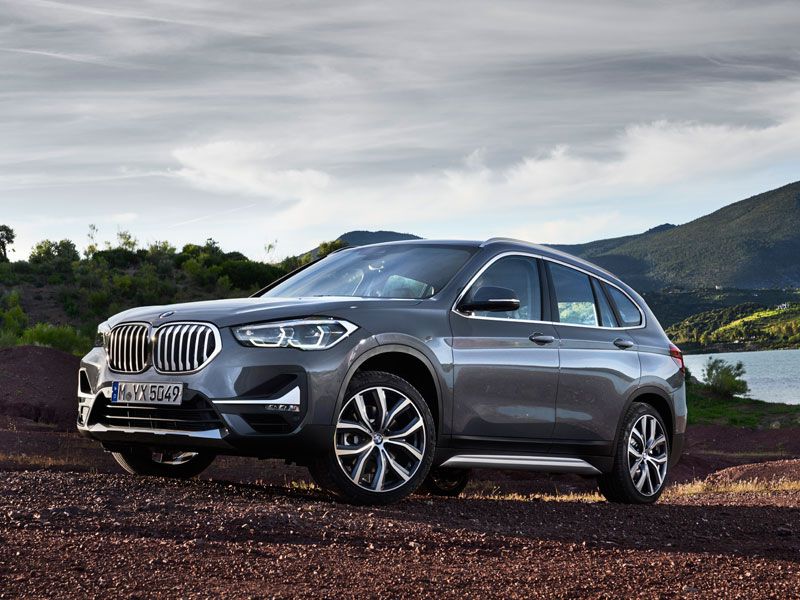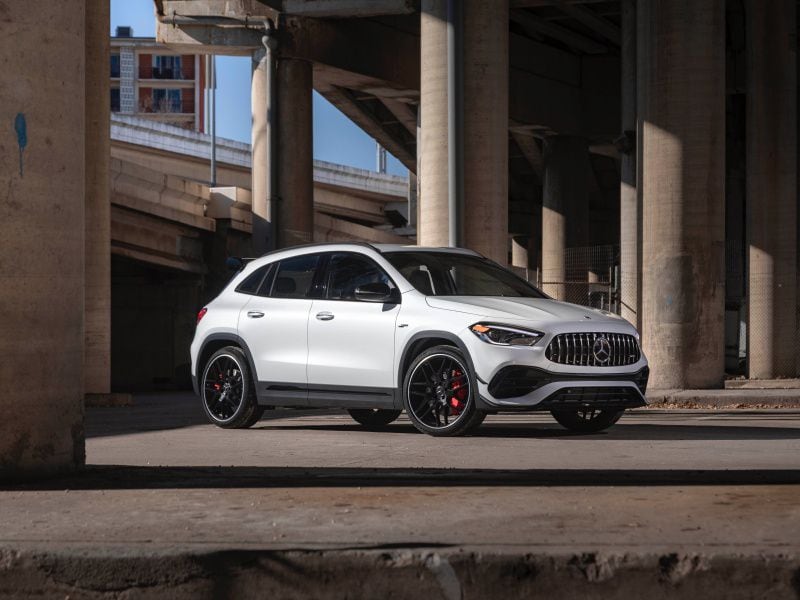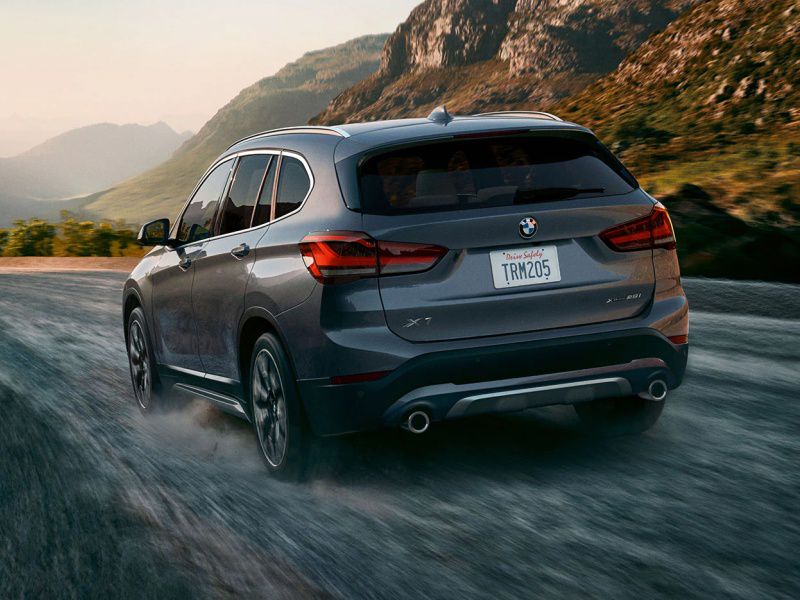Recent Articles
Popular Makes
Body Types
2022 Mercedes-Benz GLA vs. 2022 BMW X1

2021 Mercedes-Benz GLA 250 ・ Photo by Mercedes-Benz
The Mercedes-Benz GLA and BMW X1 compete tooth-and-nail in the burgeoning luxury compact crossover SUV segment. Both vehicles play to their respective brand's strengths. The GLA trades on the styling of its larger Mercedes-Benz brethren, while the BMW X1 leverages the brand's driver's-car orientation. At the same time, both vehicles deviate from their marques' norm by being front-drivers in base form.
BMW and Mercedes-Benz are among the last holdouts for rear-drive architecture across the bulk of their lineups. Of course, to give themselves full SUV cred, both the X1 and the GLA offer all-wheel-drive versions. The two vehicles are about the same size and boast similar upscale five-passenger interior accommodations. Truth be told, four passengers will probably be much more comfortable than five in either one. For young singles and empty-nesters, the BMW X1 and Mercedes-Benz GLA deliver versatile upscale transport. They are equally at home in an urban setting or negotiating a high-mountain pass. Here is our comparison of the 2022 Mercedes-Benz GLA and 2022 BMW X1.
Exterior Style
The designers of the BMW X1 and Mercedes-Benz GLA knew that buyers of these vehicles desire the prestige associated with their brands. So despite the fact that they were dealing with front-drive-oriented chassis, they styled the vehicles to look as much like larger members of each brand's portfolio as possible. The GLA is offered in two "standard" forms — GLA 250 and GLA 250 4Matic — and two specialty-performance models— the Mercedes-AMG GLA 35 and Mercedes-AMG GLA 45.
BMW counters with just two versions of the X1 — the sDrive 28i and xDrive 28i. From an appearance standpoint, the two BMWs are very similar, while the AMG versions of the GLA differ from the others with sportier wheels, tires, and trim. The X1 is about two inches longer than the GLA, while the GLA is about half an inch taller than the X1. Both small crossovers offer optional panoramic sunroofs. The Mercedes-Benz GLA can be optioned with AMG Line packages meant to give the vehicle a performance-oriented look.
: BMW X1

Photo by BMW
Interior Design
The Mercedes-Benz GLA and BMW X1 have interiors that deliver brand-appropriate levels of luxury and convenience, despite the fact that they are on the lowest rungs of the crossover food chains of their brands. The 2022 Mercedes-Benz GLA offers front-seating positions that are higher by 3.8 inches than in the previous-edition GLA. About 5.5 inches higher than the seats in the A-Class sedan, the front seats are comfortable, well-padded, and power-adjustable. The standard multi-adjustable rear seat can be moved fore-and-aft 5.5 inches, and the backrest is split 40/20/40 versus the typical 60/40. The BMW X1, while longer than the GLA, has a lower roofline, but it still manages to give a decently high seating position while offering an inch more headroom than the GLA. The X1's seats are comfortable, and the front-seat passengers will appreciate the 8-way power adjustments. In the X1, sliding and reclining rear seats are optional and worth the investment because they vastly increase the vehicle's versatility. Both vehicles enable buyers to add luxe features with a string of appearance and convenience options.
: Mercedes-Benz GLA

Photo by Mercedes-Benz
Infotainment & Technology
The BMW X1 and Mercedes-Benz GLA offer leading-edge infotainment systems. The 2022 BMW X1's infotainment array features an 8.8-inch screen at the top of the dash. The iDrive system is controlled with a console-mounted rotary knob accompanied by buttons that enable users to go directly to certain functions. At least until they learn the system, some might find a touchscreen system more convenient. Apple CarPlay compatibility is standard, but the infotainment system does not accommodate Android Auto. On the plus side, integral navigation and voice recognition are standard. Wireless-device charging is a standalone option.
The 2022 GLA's infotainment system features a 7-inch in-dash screen, and the infotainment interface can be controlled with a console-mounted touchpad, voice commands, or by touching the screen itself. Apple CarPlay and Android Auto compatibility are standard, and the MBUX system offers "natural-speech" voice recognition. The standard navigation system offers both two- and three-dimensional map views and augmented reality facilitated by a roof-mounted camera.
: Mercedes-Benz GLA

Photo by Mercedes-Benz
Powertrains
The BMW X1 and the Mercedes-Benz GLA offer very similar standard powertrains. The GLA also has a couple of high-performance options the X1 doesn't match. The X1 has a single engine — a 2.0-liter turbocharged four-cylinder that is widely used in other BMW vehicles. The engine produces 228 horsepower and 258 lb-ft of torque and it has been tuned to deliver peak torque at low- and mid-range rpm. The X1 has an eight-speed automatic transmission. The major bow to performance is the M Sport package with a revised transmission featuring shift paddles. The 2022 Mercedes-Benz GLA 250 has a 2.0-liter turbocharged four-cylinder that produces 221 horsepower and 258 lb-ft of torque. It's teamed with an eight-speed dual-clutch automatic transmission. At the same time, Mercedes offers not just one but two performance-oriented AMG versions of the GLA. The GLA 35 offers 302 horsepower and the GLA 45 delivers a rollicking 382 horsepower.
: Mercedes-Benz GLA

Photo by Mercedes-Benz
Driving Impressions
With their standard powertrains, the BMW X1 and Mercedes-Benz GLA deliver good acceleration and better-than-average handling accompanied by a comfortable ride. BMW says the sDrive 28i will accelerate from zero to 60 mph in 6.3 seconds, while the xDrive 28i will turn the trick in 6.6 seconds. Mercedes-Benz says the (all-wheel-drive) GLA 250 4Matic will go from zero to 60 mph in 6.8 seconds. So the two small suvs offer very comparable performance. But the Mercedes-AMG GLAs deliver significantly elevated performance with their more powerful engines. Mercedes claims the AMG GLA 35 can accelerate from zero to 60 mph in 5.1 seconds, and the AMG GLA 45 will do it in just 4.3 seconds. The AMG models have tires and suspension tuning to match their enthusiast potential, but some buyers in the segment might find them too extreme.
: Mercedes-Benz GLA

Photo by Mercedes-Benz
Safety & Driver Aids
When it comes to safety and driver-assistance features, both the BMW X1 and Mercedes-Benz GLA offer a wide array. At the same time, some items are optionally available rather than standard. The X1's BMW Active Driving Assistant includes lane departure warning, pedestrian warning with automatic braking, frontal collision warning, low-speed collision mitigation with automatic braking, speed limit information, and automatic high beams. Standard real-time traffic information is valuable for convenience and safety. Adaptive cruise control with stop-and-go is a standalone option on the X1.
The GLA's standard safety technologies include active brake assist, blind spot assist, crosswind assist, and driver attention monitoring. Adaptive cruise control with stop-and-go, active steering assist, evasive steering assist, and active braking assist with cross-traffic are among the optional safety systems. Active emergency braking, lane-keeping assist, active blindspot assist, active lane-change assist, speed limit assist, and route-based speed assistance are also optional. The GLA's optional active LED headlights are fitted with adaptive high-beam assist. And an automatic parking system is available.
: Mercedes-Benz GLA

Photo by Mercedes-Benz
Interior Space & Cargo Carrying
The Mercedes-Benz GLA is taller than the BMW X1, but partly because it is shorter in length, it has less cargo-carrying capacity. In fact, the closely related and boxier Mercedes-Benz GLB 250, which is seven inches longer than the X1, also has less cargo space than the X1. The Mercedes-Benz GLA 250 has 15.4 cubic feet of cargo space and the GLB 250 has 22 cubic feet, while the X1 has 27.1 cubic feet. The GLA offers 50.5 cubic feet of cargo space with rear seats folded, and the X1 offers a more robust 58.7 cubic feet of cargo space. (Incidentally, the GLB 250 offers 62 cubic feet of cargo space with the rear seats folded.) From a dimensional point of view, the X1 offers more rear-seat space than the GLA, but in everyday use, passengers are unlikely to notice a difference.
: BMW X1

Photo by BMW
Fuel Economy
The Mercedes-Benz GLA 250's fuel economy is at the top of its competitive set, but its margin over the BMW X1 is very narrow. According to the EPA, a front-drive GLA 250 with the 2.0-liter turbocharged four-cylinder engine delivers an estimated 24 mpg in the city and 34 mpg on the highway. All-wheel drive drops fuel economy by 1 mpg in city driving and by 2 mpg on the highway. A front-drive BMW X1 sDrive 28i with its 2.0-liter turbocharged four-cylinder engine delivers an estimated 24 mpg in the city and 33 mpg on the highway. Similar to the GLA, all-wheel drive lessens fuel economy by 1 mpg in city driving and by 2 mpg on the highway. The high-performance Mercedes-AMG GLA 35 is estimated to achieve 22 mpg city/30 mpg highway. The AMG GLA 45 is rated at 19 mpg in the city and 25 mpg on the highway.
: Mercedes-Benz GLA

Photo by Mercedes-Benz
Pricing & Value
The two vehicles considered in the comparison are from longtime rivals, so it isn't surprising how closely they resemble each other in capabilities and convenience features. It's also not surprising that they are closely matched in price. The base GLA 250 starts $1,000 higher than the base BMW X1 sDrive28i, which has a suggested list of $35,400 plus destination charge. The slightly larger and more commodious Mercedes-Benz GLB 250, which shares a great deal with the GLA 250, has a base price of $38,600 plus destination, $200 more than the GLA. Shifting to the all-wheel-drive versions of each vehicle adds $2,000 to their list prices. Sliding to the high-performance Mercedes-AMG models is a more costly move. The AMG GLA 35 has a list price right around $48,000, and the AMG GLA 45 takes the starting price up to about $55,000. On the basis of its slight edge in horsepower and cargo-carrying abilities at a somewhat lower list price, one could give the edge to the BMW X1 for value.
: BMW X1

Photo by BMW
The Winner
It's not hard to see that the contenders in this comparison are very evenly matched. Since their looks, performance, and features are virtually identical, one way to choose between them is to pick the one you like best from a visual standpoint. And even by that standard, it's hard to choose, although we are certain some of you favor BMWs while others prefer the three-pointed star. Perhaps because the current-generation Mercedes-Benz GLA is newer than the BMW X1, it was victorious in the majority of the categories. Furthermore, it offers performance variants the X1 does not. So for those reasons, we hereby declare the Mercedes-Benz GLA the overall winner.
: Mercedes-Benz GLA

Photo by Mercedes-Benz